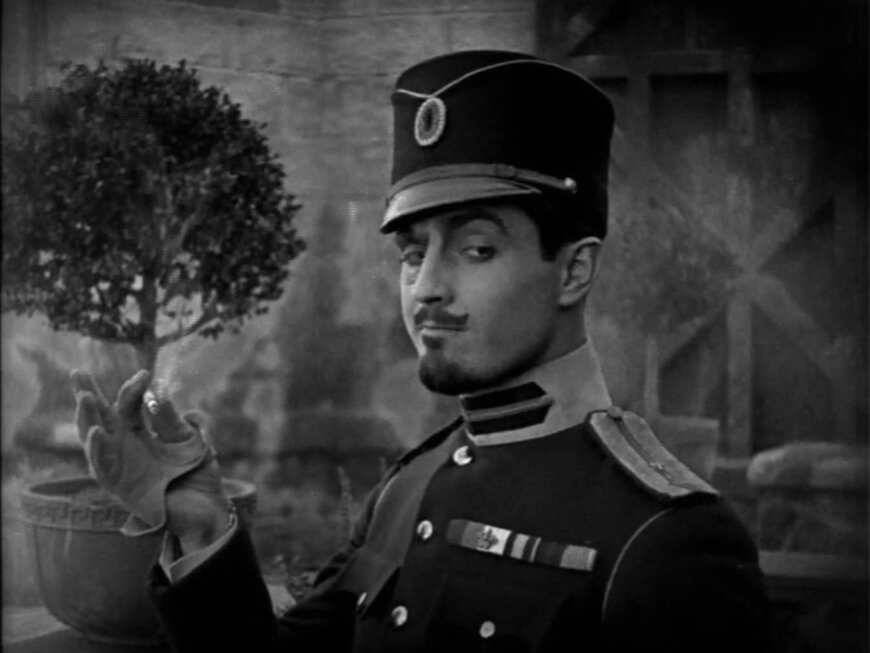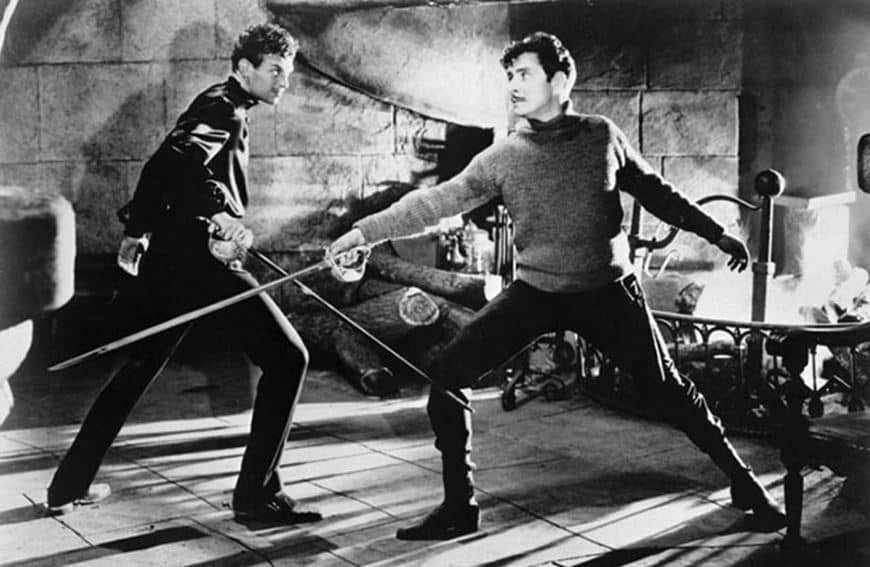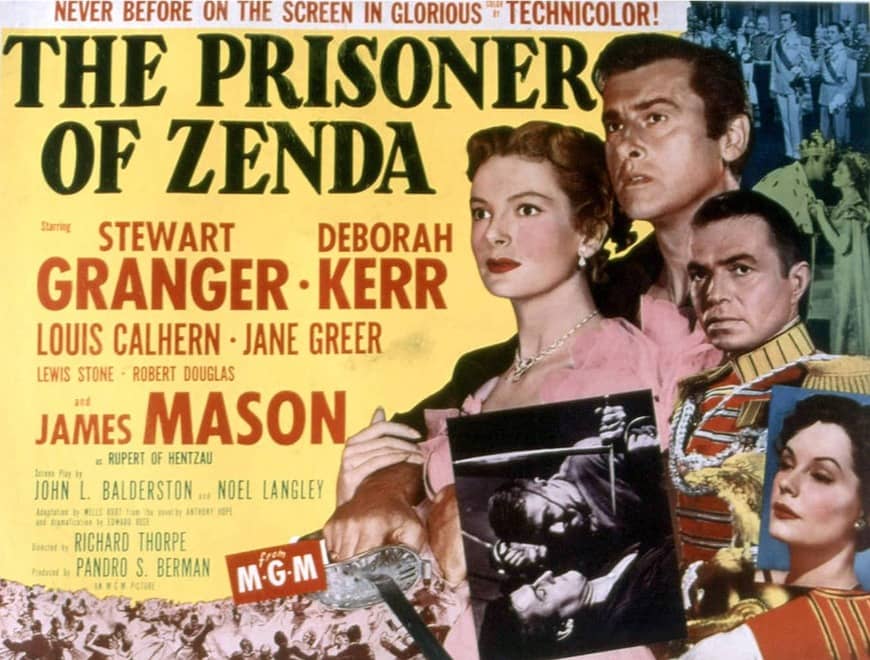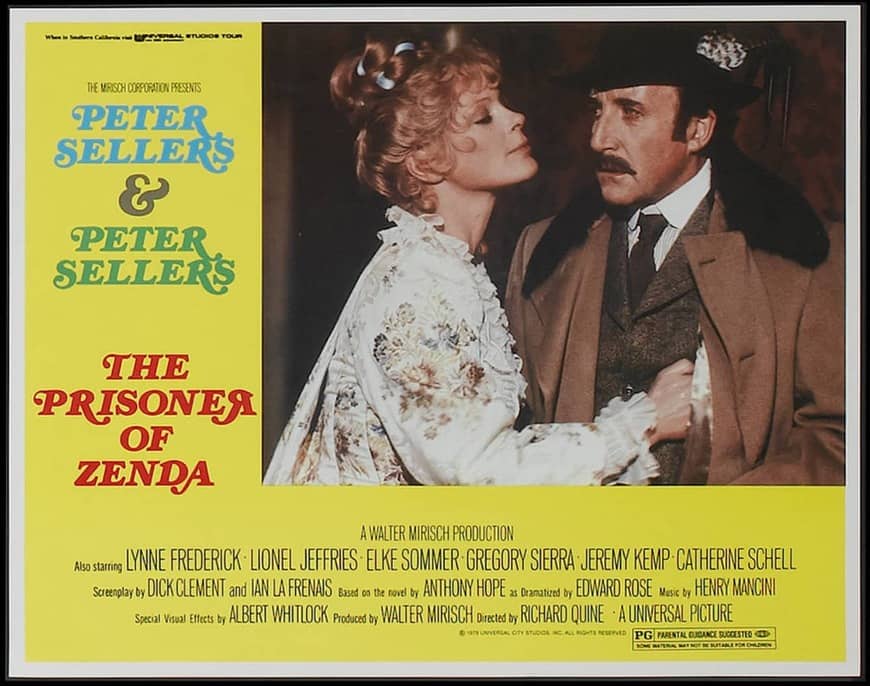Ellsworth’s Cinema of Swords: So Many Prisoners of Zenda
The Prisoner of Zenda (USA, 1922)
Sir Anthony Hope Hawkins (1863-1933) wrote some thirty-two books, mostly novels, many of them bestsellers that were adapted to stage and screen. Today he is remembered only for his swashbuckler The Prisoner of Zenda (1894) and its sequel, Rupert of Hentzau (1898). Both were set in the fictional principality of Ruritania, and were so popular that they spawned a host of imitators known as “Ruritanian romances.”
A littéraire at Oxford, Hawkins took a first in Classics at Balliol College, then a law degree. He settled into work as a barrister in the City in London, but the time weighed heavily on his hands, so he turned to writing. His first literary success, The Dolly Dialogues (1894), established the pattern for most of his novels, wry commentaries on London society mixing romance with politics. His second success was The Prisoner of Zenda, a rollicking adventure in a very different mode. Tastes have changed, and nowadays Hope’s Edwardian comedies of manners are largely forgotten, but The Prisoner of Zenda, with its iconic dash, flair, excitement, and humor, lives on.
The Prisoner of Zenda (1922)
Rating: ***
Origin: USA, 1922
Director: Rex Ingram
Source: Warner Bros. DVD
This film, the third silent movie adaptation of Anthony Hope’s best-selling 1894 novel (the first two are lost, alas), features craggy-faced Lewis Stone in the dual parts of Rudolf Rassendyll and King Rudolf, which he had also played in the theatrical version this film was based on. Even better is Ramon Novarro, in his breakout role, as the villain Rupert of Hentzau. Every version of Zenda is stolen by the engaging rogue Rupert, and this is no exception — and Novarro’s raffish charm in the part made him a star.
The movie starts slow, and its talky set pieces betray the production’s origins as a stage play, but the emphasis on interiors and close-ups gives plenty of scope for mugging by an array of fine silent-screen character actors. A great deal of effort was put into Ruritanian pomp and display that hasn’t aged well and the story doesn’t really pick up until over an hour into it — but once the action starts, there’s actually more swordplay than in the better-known 1937 and 1952 versions. The last forty minutes definitely redeem the previous seventy, and the fencing in the final scenes is better than anything seen previously in the silent era. Visual Bonus: monocles and jodhpurs!
The Prisoner of Zenda (1937)
Rating: *****
Origin: USA, 1937
Director: John Cromwell
Source: Warner Bros. DVD
David Selznick bought the rights to The Prisoner of Zenda as a starring vehicle for Ronald Colman, who was at the height of his fame just after Lost Horizon (1937). Colman played the dual role of Rudolf Rassendyll and King Rudolf, and Selznick surrounded him with a first-rate cast, including the glowing Madeleine Carroll as Princess Flavia, and C. Aubrey Smith and his whiskers as the king’s loyal Colonel Zapt. But best of all were the villains: Raymond Massey, looming and ominous as the would-be usurper Black Michael, and Douglas Fairbanks, Jr., as the raffish rogue Rupert of Hentzau, who stole every scene he appeared in (as Rupert does in every version of Zenda).
The story sticks pretty closely to that of Anthony Hope’s 1894 novel — and if you’re not familiar with it, why are you wasting time reading this? (Side note: the best of Hope’s Zenda short stories is included in my anthology, The Big Book of Swashbuckling Adventure.) On the eve of his coronation, King Rudolf of Ruritania is kidnapped, but his loyal aides convince his lookalike English cousin to stand in for him. While impersonating his royal cousin, Rassendyll falls in love with the king’s betrothed, Princess Flavia — and she with him. Heartbreak ahead! Meanwhile, good guys Colonel Zapt and Fritz von Tarlenheim (a very young David Niven) engage in a desperate dance with the villains, as nice and nasty try to outmaneuver each other before their various threats and ultimatums erupt in violence.
Besides the brilliant performances, there’s so much to love in this movie: drugged wine, secret passages, throwing knives, and brooding Castle Zenda, so medievally murderous it’s practically a character unto itself. The outrageous helmets and embroidery-crusted uniforms of the Ruritanian nobility and guards cannot be improved upon. And everybody wears monocles! So fine.
In the end it all comes down to swordplay, of course, in a climactic duel filmed by James Wong Howe, who projected the duelists’ shadows thrice life-size on the inner walls of Castle Zenda. (Yes, this is where that trope originated.) The Oscar-nominated soundtrack by Alfred Newman was so good it was reused in the 1952 remake. Fun factoid: When the first theatrical production of Zenda was the hit of the London stage in 1896, the dual role of Rudolf and Rassendyll was played by … C. Aubrey Smith. (Pre-whiskers!)
The Prisoner of Zenda (1952)
Rating: ****
Origin: USA, 1952
Director: Richard Thorpe
Source: Warner Bros. DVD
If you want to recapture the essence of a classic movie in a new version, I guess a shot-for-shot remake is one approach. The 1952 Zenda used the same shooting script as the 1937 version with just a few changes, and even a cursory comparison shows that scenes, set-ups, and shooting angles are virtually the same in both. They even repurposed Alfred Newman’s excellent score from the earlier film. But though the newer version is just as well made as its predecessor, it lacks some of the spark or spirit of the Ronald Colman film. Why is that? The qualities of the ’37 version certainly weren’t the result of spontaneity or serendipity — it was shot, cut, re-shot, and re-cut until the studio finally had what they wanted. And Zenda already had a long history on stage and film, with three previous silent versions. Perhaps it was that the ’37 version aspired to be better than what had gone before, while the ’52 version only aimed to be as good — and that just wasn’t aiming high enough.
The story is still great, and there’s no denying that Ruritania and its comic-opera uniforms look better in Technicolor, even if we miss James Wong Howe’s dueling shadows. But a Zenda stands or falls on its hero, the twin cousin Rudolfs, and their nemesis, Rupert of Hentzau. The ’37 version had the mature Ronald Colman as Rudolf playing off the brash young Douglas Fairbanks, Jr. as Hentzau. The ’52 remake flips this, pitting the energetic young Stewart Granger as Rudolf against the seasoned and sophisticated James Mason as Hentzau — and yes, it works. Granger is confident and likeable, and lithe enough for some acrobatic swashbuckling. Furthermore, like Basil Rathbone and Cornel Wilde, he’s a serious fencer: Mason had to be doubled by an expert in the final, heart-stopping saber duel in Zenda Castle, but that’s Granger all the way. Put a sword in Granger’s hand, and Colman is eclipsed.
Ah, but when it comes to the love story, the sly and nuanced Colman easily outdoes the new guy. Nonetheless, Deborah Kerr as the new Princess Flavia holds her own compared to Madeleine Carroll, and maybe even edges her out. As for the rest of the supporting cast — Louis Calhern, Robert Douglas, et al. — they all carry their weight, but can they compare with Raymond Massey, David Niven, and C. Aubrey Smith? Sorry — there the ’37 entry gets the nod. That said, the Granger version is still top-notch entertainment, and who doesn’t want to pop a monocle over his eye and spend another two hours in Ruritania? Bonus: watch for craggy old Lewis Stone playing the Cardinal of Strelsau — Stone, the man who starred as the twin Rudolfs in the silent 1922 version!
The Prisoner of Zenda (1979)
Rating: **
Origin: US, 1979
Director: Richard Quine
Source: Fabulous DVD
Peter Sellers was one of the greatest comic actors in the history of film. It’s a shame to see him, at nearly the end of his career, involved in this tedious and ill-considered mistake.
This movie attempts to take Anthony Hope’s Victorian-era romantic adventure and make it a comedy by inverting some of its key assumptions. But then they forgot to make it funny. In the original story, the double of imperiled King Rudolf of Ruritania is a dashing English gentleman; here, as a twist, the double is a stolid and rather dull London cabdriver named Sydney Frewin. Sellers plays both Rudolf and Frewin, but where the king is a hilariously irresponsible aristocratic twit, the cabby is such a matter-of-fact salt-of-the-earth workman who greets danger with a shrug that it drains the interest out of every situation. After the king is kidnapped and the cabby takes his place, Frewin must face not only the assassins sent by the king’s half-brother Prince Michael (Jeremy Kemp), but the jealous husband of a countess (Elke Sommer) who keeps trying to get into his bed. Yes, they added a bedroom farce. Sound like a good time? It isn’t.
Another inversion is to take Michael’s scoundrel accomplice, Rupert of Hentzau (Stuart Wilson), and change him from one of the most engaging rogues in swashbuckler fiction into an arrogant private-school bully with an irritating laugh. (His laugh is so irritating that Frewin even points it out, just in case you’d missed it.) Thanks for that.
In general, the jokes are weak, every gag is telegraphed a mile off, and worse, this movie just plods. Okay, there is exactly one funny scene, when two groups of conspirators get confused signaling to each other in the dark woods with owl hoots and chicken clucks. Lionel Jeffries is fine as the mutton-chopped old royal retainer Colonel Sapt, and Kemp is pretty good as Prince Michael. And they spent a jillion dollars on the costumes and sets, which include Schönbrunn Palace in Austria, but elaborate costumes and sets don’t make a comedy any funnier. Toward the end the movie gives up on the jokes and tries to slide back into romantic adventure, but Peter Sellers, for all his many talents, is no swashbuckling action hero, and it just doesn’t work out. What a misbegotten mess.
Where can I watch these movies? I’m glad you asked! Many movies and TV shows are available on disk in DVD or Blu-ray formats, but nowadays we live in a new world of streaming services, more every month it seems. However, it can be hard to find what content will stream in your location, since the market is evolving and global services are a patchwork quilt of rights and availability. I recommend JustWatch.com, a search engine that scans streaming services to find the title of your choice. Give it a try. And if you have a better alternative, let us know.
Previous installments in the Cinema of Swords include:
Lone Wolf and Cub, Part I
Premium Peplum
The Book Was Better
Shogunate’s End
Peak Musketeers
Lone Wolf and Cub, Part 2
Arthur, King of the Britons
Sinbads Three
Premium Peplum: Top Hercs
Fight Direction by William Hobbs
Mash-Up or Shut Up
Classics on Screen — 1977
Wuxia in the Time of Kung Fu
LAWRENCE ELLSWORTH is deep in his current mega-project, editing and translating new, contemporary English editions of all the works in Alexandre Dumas’s Musketeers Cycle, with the fifth volume, Between Two Kings, coming in July from Pegasus Books in the US and UK. His website is Swashbucklingadventure.net.
Ellsworth’s secret identity is game designer LAWRENCE SCHICK, who’s been designing role-playing games since the 1970s. He now lives in Dublin, Ireland, where he’s writing Dungeons & Dragons scenarios for Larian Studios’ Baldur’s Gate 3.




Don’t forget the Great Race! The whole last third of that (looong) movie is a spot-on Prisoner of Zenda parody, with one of the great sword fights ever – the saber duel between Tony Curtis and Ross Martin.
Yes! Thanks for highlighting this segment of an awesome movie! Hands down my fav film as a kid!
I have only read Prisoner of Zenda. I am now wondering if I should read any of his other work. (I was talking about how I’ve only read Bram Stoker’s Dracula and have wondered about his other work.)
The Prisoner of Zenda seems to be one of those classic plots that is ripe for stealing and parody. The most famous example is probably Royal Flash by George MacDonald Fraser. There was even a two-issue story in the comic Jon Sable, Freelance that was inspired by it. (Though it played with the storyline in interesting ways.)
If you enjoyed Prisoner of Zenda, its sequel, Rupert of Hentzau, is essential, and the short story The Sin of the Bishop of Modenstein is very good. The rest of Hope’s output can be safely ignored.
Great article about a story that somehow still seems indispensable even in our “modern” world. Read the book as a kid or teenager and remember enjoying it; have been intrigued for years that the author actually wrote a sequel that’s also highly regarded (although I haven’t read it). Love the references to the actors appearing in multiple versions of the story!
Another Ellsworth’s Cinema of Swords? The Zendas!
I really like the 1952 film but it is the 1937 movie that I think of when I hear anyone mention the Prisoner of Zenda. It’s just a magnificent film (and read David Niven’s autobiography for why you must be careful mixing stallions and mares on a movie set) with a great cast at the top of their game.
I’ve never seen the 1922 silent but I’m going to look for it from now on, and I’ll be sure to give that 1979 version a pass.
I agree with Mr. Parker, that duel between Tony Curtis and Ross Martin is great!
Thank you again, Mr. Ellsworth, for pointing us towards film treasures many of us never knew existed. Great post!
There’s also Royal Flash, which is another comic retelling of Prisoner of Zenda.
When Doulas Fairbanks Jr. was approached to play Rupert, he was reluctant at first, but his father (the great Doug Fairbanks Sr. who invented the movie swashbuckler) ) told him he would be crazy not to play him, it was the best part in literature, and that he should insist that his costume be all black and quite simple, so as to contrast with the other players.
And I think it’s by far the best performance Junior ever gave.
Just a great story with wonderful characters. I saw the Peter Sellers version in the movie theater, it’s even worse on the big screen. The best parody was in the old TV show, GET SMART.
If you like The Prisoner of Zenda, you may find Rupert of Hentzau disappointing. Those are the only two of his books I’ve been able to find in library or bookstore. I love both the Stewart Granger and the Ronald Colman versions of the movie.
You inspired me to watch the 1922 version. What a great movie! Thank you.